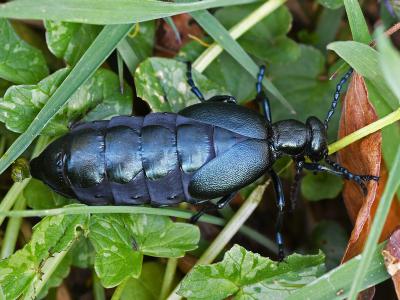 The National Oil Beetle Recording Scheme collates records for oil beetles and allies in the family Meloidae, of which there are 11 UK species. The scheme was established in February 2021 and is organised by Liam Olds.
The National Oil Beetle Recording Scheme collates records for oil beetles and allies in the family Meloidae, of which there are 11 UK species. The scheme was established in February 2021 and is organised by Liam Olds.
If you have seen an oil beetle, please add your record to iRecord (with a photo if at all possible), or contact the scheme to send it in direct.
Oil beetles are conspicuous, charismatic beetles that are so-called because they exude a yellowish oily substance from their leg joints when threatened. Oil beetles have an extraordinary life-cycle that is intricately linked to that of solitary bees. After hatching, oil beetle larvae (known as triungulins) make their way onto a flower head where they lie in wait for a solitary bee. Using specialised hooks on their feet, they attach themselves to the back of a visiting solitary bee female and when the bee returns to its underground nest, the triungulin disembarks and continues its development underground, eating through the bee’s stores of pollen and nectar. The following year, it emerges as an adult oil beetle ready to start the life-cycle all over again.
Such specialised life-cycles make oil beetles particularly vulnerable to environmental change. Declines in the quality and quantity of solitary bee habitat have contributed towards declines in solitary bees and, along with them, oil beetles. Three of the UK’s oil beetles are now presumed extinct (Meloe autumnalis, M. cicatricosus and M. variegatus), while many of our remaining species have suffered serious declines. Oil beetles are therefore considered a priority for conservation in the UK.
The National Oil Beetle Recording Scheme aims to generate records of these beetles to help us to understand more about their abundance, distribution and ecology in the UK. Members of the public, amateur and professional entomologists are encouraged to take part in the UK Oil Beetle Survey and submit records by adding them to iRecord, using the iRecord app, or sending in details via email. These records will also be shared with the Tenebrionoidea Recording Scheme and the NBN Atlas.
For help with the identification of oil beetles in the genus Meloe, you can use the Buglife Oil Beetle Identification Guide. This guide is also available in Welsh.
For more information, contact Liam Olds or via Twitter at @OilBeetlesUK.
(Photo above by Liam Olds shows Violet Oil Beetle, Meloe violaceus.)
Oil beetle recording
You can add records via the iRecord website or app (Android or Apple). If you have an iRecord account it is best to log in before adding a record. If you don't have an iRecord account you can still add records to the website, but if you want to be able to review your records on iRecord and (optionally) to receive notifications about your records, please register with iRecord first. Please add a photo with your record if you can.